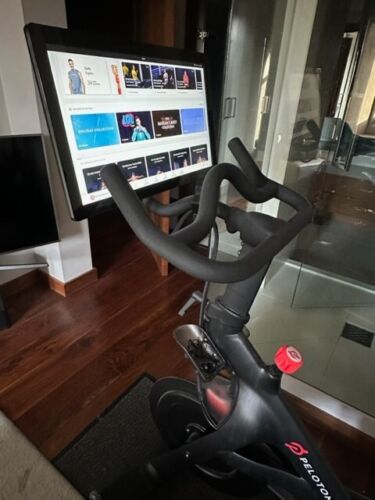Cycling lessons are only one of several interactive exercises available on the Peloton fitness platform. While most of the time, using Peloton is a breeze, there will always be occasions when you need assistance with your bike.
When the Peloton cadence sensor malfunctions, it’s a regular complaint from riders. This article will review Why Is Peloton Cadence Not Working, several possible causes of a non-functioning Peloton cadence and how to fix it.
Peloton Cadence Not Working

A faulty Peloton cadence sensor might be due to several different factors. Possible causes include
- insufficient power
- a misaligned sensor
- a dirty or sweaty surface
- a faulty connection
It’s necessary to replace the sensor in specific circumstances. If your Peloton cadence sensor is malfunctioning, you must first identify the root cause of the problem before you can fix it.
What Is Peloton Cadence Sensor?
Now, let’s define the Peloton cadence sensor to proceed with debugging. The Peloton bike’s cadence sensor is a gadget that fits onto the crank arm. It monitors your pedaling speed and relays that data to the Peloton app in real-time so you can keep tabs on your cadence.
Why Is Peloton Cadence Not Working? Reasons & Easy Solutions
Peloton is a widely used fitness app that allows users to participate in various interactive exercises, such as cycling classes. All Peloton bikes, for example, include a cadence sensor that can track how fast you’re cycling. You can track your cadence in real time by sending this data to the Peloton app.
On occasion, though, your Peloton cadence may not function as intended. In this section, we’ll discuss the most common reasons why a Peloton cadence not working or a sensor stops functioning and various fixes to get your bike up and running again.
Dead Battery
Dead batteries are a typical reason for a malfunctioning Peloton cadence sensor. You won’t be able to view your cadence on the Peloton app if the cadence sensor’s batteries are dead since the sensor won’t be able to send data to the app.
Solution
Use these procedures to determine how much power is left in your battery:
- Choose “Sensors” from the Peloton menu of options.
- To check the power reserve, go to the “Cadence” menu.
- New batteries should be installed if the battery life is short or damaged.
Loose Linkage
A loose connection is another typical reason for a malfunctioning Peloton cadence sensor. If the cadence sensor’s connection to the bike’s crank arm becomes loose or broken, the sensor can no longer send data to the Peloton app.
Solution
Follow these steps to ensure a proper connection:
- On the pedal’s crank, you’ll find the cadence sensor.
- Make sure the sensor is firmly fastened to the pedal.
- Make sure that no connections are broken and that no wires are dangling.
- The sensor’s connection to the crank arm should be checked and adjusted. The cadence sensor should be replaced if any wires or connections are broken.
Unclean Sensor
The cadence sensor’s ability to connect with the app might be disrupted if it gets filthy or sweaty over time.
Solution
Below are the actions you should take to clean the sensor:
- If dirt or perspiration has accumulated on the sensor, you can wipe it off with a moist cloth.
- Use a dry towel and wipe the sensor down.
Errors In Calibration
If none work, you may need to calibrate your cadence sensor.
Solution
Below are the measures to take for sensor calibration:
- Choose “Sensors” from the Peloton menu of options.
- Choose “Cadence,” then “Calibrate,” to adjust the rhythm.
- Calibrate the sensor by following the on-screen directions.
Change Sensors
If none of those work, consider getting a new cadence sensor. You must bring your bike in for servicing or contact Peloton support for instructions on replacing the sensor.
Avoiding Future Problems
There are a few things you can do to maintain the longevity of your Peloton cadence sensor:
Solution
- Always have fresh batteries on hand.
- After each usage, wipe down the sensor.
- Inspect the sensor’s connection to the crank arm and tighten loose screws or bolts.
Tips To Maintain Peloton Cadence
Cadence sensor upkeep is crucial for a trouble-free and satisfying Peloton session. Here are some suggestions for ensuring the continued functionality of your cadence sensor:
Keep The Sensor Clean At All Times
Sweat and grime accumulate on the sensor and need to wipe away with a moist cloth after each use. This will ensure the sensor’s connection to the Peloton app is not disrupted.
Frequently Replacing Batteries
Keep an eye on the cadence sensor’s battery life and swap them out when they become low. Use CR2032 batteries, as these are what Peloton suggests.
Be Sure Your Connection Is Safe
Ensure that the cadence sensor is connected properly and firmly linked to the bike’s crank arm. Incorrect or even completely absent readings come from a connection that needs to be fixed.
Sensor Calibration
Adjust the sensor’s settings to get more precise data if your cadence readings seem off. To calibrate the sensor, use the Peloton app and follow the on-screen prompts.
And follow these guidelines, your Peloton cadence sensor should last for many more sessions, and you won’t have to worry about it breaking down on you.
Conclusion
Now you have an idea why is your Peloton Cadence Not Working. You can do a few things if your Peloton cadence sensor isn’t functioning properly. There are options for fixing this, including replacing the batteries, cleaning the sensor, or contacting Peloton’s customer service. If you take precautions, your Peloton cadence sensor should continue functioning flawlessly, allowing you to get the most out of your exercises.
Related Articles:
- Why Peloton Touch Screen Not Working – Troubleshoot Guide
- How To Maintain a Peloton Bike And Bike+? Step- by- Step Guide
- Is Peloton Extended Warranty Worth It? (Why And How
- Learn How To Turn On/Off Peloton? Peloton At Your Fingertips
- How Can You Listen To Your Own Music On Peloton? Customize & Ride
- What is Peloton Fastboot Mode? Advanced Troubleshooting Pro-Tip
- Can You Pause a Peloton Ride? Pause, Resume, and Repeat!
- How To Reset Your Peloton Bike And Bike+ like A Pro
- Does Your Peloton Making Noise when Pedaling- Easy Fix
